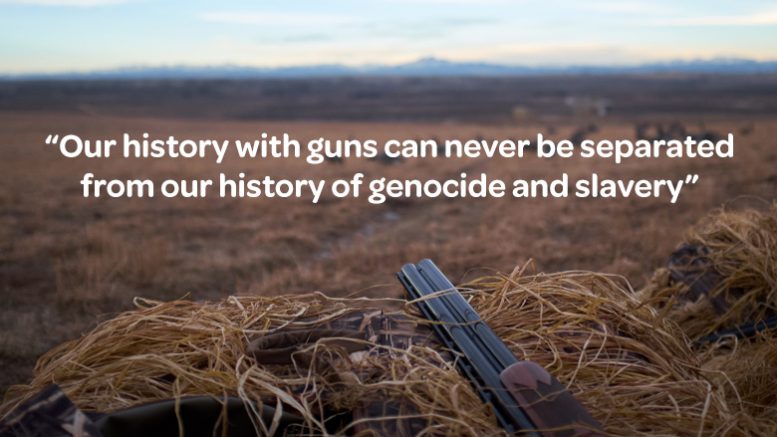Full disclosure up front: I own guns, some inherited, a couple purchased. I shoot, clean, and oil each of them annually.
We have a violence problem in the United States, always have had. As has been pointed out above, it has a great deal to do with the country having been built on the violent genocide of indigenous people and the equally violent enslavement of a captive people. Our history with guns can never be separated from that history. Gun ownership today is often still bound up with the ethos of racist violence.
I grew up effectively without guns, but joined the military (for sundry reasons irrelevant here) in my youth and discovered that I had a talent for shooting. I got a .22 target rifle a few years after my discharge to practice shooting with. It had no other purpose at the time, and while dangerous to humans it would be a poor choice for deliberate violence against anything bigger than a raccoon. Since moving to the country I keep it loaded and hanging over my studio door in case of any sudden need to protect my chickens or geese from the marauding hounds my neighbors are sometimes lax about keeping contained. (Happily, I’ve never yet had to use it for this purpose. But I will if needed.) I later inherited a couple pistols (one irreparably broken) and a hunting rifle. At my wife’s request I purchased a pistol for her. Recently I traded the rifle (an antique) for a shotgun.
What is most troubling about the guns debate is how poorly informed it tends to be. On one side are people who fetishize gun ownership, treat it as a “natural” right like freedom of expression, have scant training, and evince little or no capacity for reckoning the danger that weapons represent to themselves and others. On the other side are folks with no experience or understanding of weapons, treat the weapons themselves as the source of the violence, and imagine that a pacified populace is a safe populace.
I don’t mean to write a thesis here, so I’ll just make a few isolated points in no particular order.
1. “Assault rifle” is a marketing term. Any modern rifle designed to fire one round at a time and automatically reload with the next round is as dangerous as any other such rifle of similar caliber. Any modern rifle can be dressed up to look like a scary “assault” weapon, and it can also be dressed up to look like your great-granpappy’s varmint rifle. Same rifle. If I buy another weapon it will be a modern rifle, probably an AR-15 or equivalent. It won’t look like an assault rifle for the same reason I don’t “cherry” my pickup with chrome and or other fancy detailing. I’m a grown-up, and my concerns are practical.
2. Any weapon is made up of many pieces, and since the late 19th-century those pieces are all interchangeable for the same make and model of weapon. Question: which piece or pieces, if removed, make it not be a weapon anymore? I ask because just that question is what the law attempts to answer. This leads to all the not-proscribed pieces being available for mail order, and the plans to fashion the missing bit(s) likewise, so that any yahoo with a few tools can have their weapon of choice without breaking any laws. With 3d-printing, anyone can have any weapon they want, without anybody selling it to them. Long story short, a ban on “assault weapons,” or any small arms generally, is completely unenforceable.
3. If I were black or indigenous or hispanic, it would come as no surprise that well-meaning white people see no irony in wanting to disarm me for my own protection.
4. Our police forces are now thoroughly militarized. That’s not for my benefit.
5. If you aren’t prepping for social breakdown, you haven’t been paying attention. I’m not saying go buy guns. I’m saying think as carefully about it as you do about other kinds of insurance.
6. The sources of violence in our culture are deep and multifarious. Cultural militarism runs very deeply in American culture, as does the ethos of retributive justice. On top of that comes the extreme militarism that has defined the country since WWII. Our popular media (i.e., propaganda) has glorified the myth of redemptive violence relentlessly for going on three generations now. Every type of conflict–virtually every social ill–has been wrapped in this narrative, to the point that non-violent narratives of dispute resolution are nearly inaccessible to the popular imagination.
7. The breakdown we are already seeing, the school shootings, the hyper-vigilance and racism of law enforcement, the epidemic of suicides, are symptoms of a deepening social pathology. We must acknowledge and address that pathology, the roots of which are both political and economical.
8. In the meantime, politically, we can and should take steps to ensure that lawful gun ownership is responsible gun ownership, somewhat analogously to car ownership (another very dangerous weapon responsible for a high daily death-count). Such laws as are enacted must have the support of the overwhelming majority of gun owners, or they are just pissing in the wind.
9. The primary obstacle to reasonable regulation of firearms is not the owners of firearms, but the profiteers, whose patronage sustains reactionary militarism in government as well as in the NRA and other such organizations. The real enemies of peace are Lockheed Martin, Raytheon, and the rest of the death merchants.
In solidarity,
B. Sidney Smith
Green Party of Virginia
